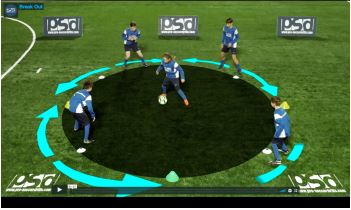The Basics of the 2v1 Situation
We are about to discuss the last segment of these. Many coach set up the tactics and the system of play to create numerical superiority on the pitch during the game. 2v1 is a numerical superiority that can be solved quite easily. This is why possession-based game styles often look for the 2v1s to break through the opponent’s defence.
We might call the solution of the 2v1 situation as a basic element just like dribbling. Even though it’s not individual technique, it should be solved by the players most of the times. But there are two sides of this coin, too. Defending a 2v1 (or it can be called 1 against 2) situation outnumbered can be a quite hard task to do, but it happens so many times during a soccer game. So let’s discuss this topic through drills and examples using real game scenarios.
Basic 2v1 situation
2v1 overload gives the players a great opportunity to get behind the opponent’s lines and find space in more dangerous areas on the pitch according to create goal scoring opportunities. The basic 2v1 situation is when the two attackers are positioned next to each other (horizontal 2v1) and the defender defends the line behind him.
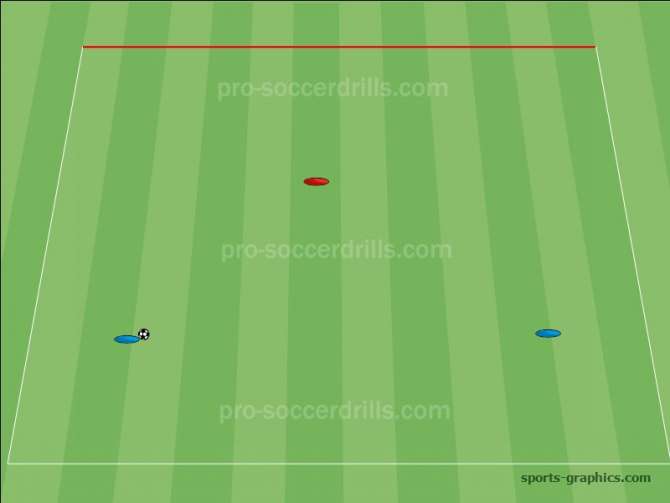
There are several drills to coach this but it’s not that easy to teach and explain it right to the players what to do and what’s the point of the training drill.
The task of the two attackers is to get behind as fast as they can. This can be reached by crossing the red line (goal line) while dribbling. Therefore the two attackers have to have only a few touches on the ball because that the fewer the touches count is, the faster they go through successfully. So time is an important factor as during in-game situations there won’t be an overload for many seconds.
The attackers have to make the defender decide and according to the red player’s decision they have to decide, too. The man on the ball should dribble the ball until the free player is in a better position than he is, so that means he should dribble it until he meets (or about to meet) the defender. The defender now, in this fast situation has two choices when getting close to the attacker: he can read the pass or he predicts that the man on the ball will not make a pass and will continue to dribble. It is now obvious that the man on the ball will decide according to this: if the defender is reading the pass, he should then dribble and vice versa.
Of course the defender can make the man on the ball harder as he can curve his run forcing the attacker go into unnecessary dribbling.
This drill helps the players make this kind of decisions: Beat the Defender - Free Choice Between 2v1 or 1v1.
As we mentioned before, 2v1s only last for a really short period of time so there are two ways defenders can win this battle: by intercepting the ball or by slowing the attackers down. We, coaches then should pay attention that these situations only a short-lasting part of the whole game of soccer. If the attackers want to win then they should be fast and accurate in decisions and execution. This mentality will make the players ready to the game but it is also very important to recognize these over-numbered situations during games.
As we have gone through the solution from the point of the attackers there is a question whether the free man has to or doesn’t have to leave his position. It really does depend on the situation on the pitch. For example, if the situation is on the left wing (and the line on the left is the sideline) then there can be a tactical approach when an overlapping run is necessary.
Just like in this drill: 2v1 Situations and Finishing.
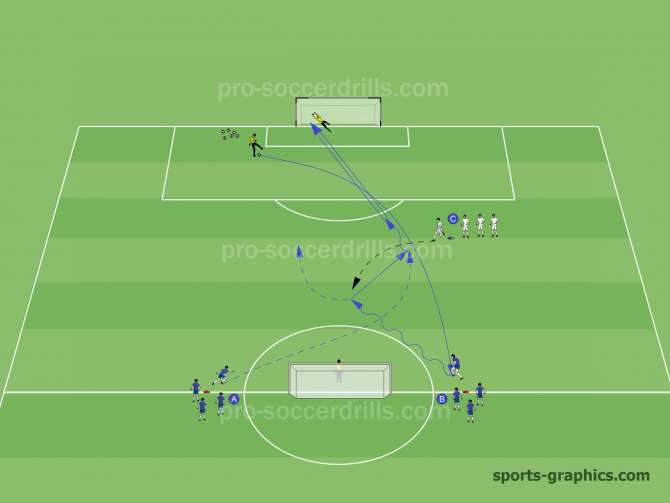
But coaches should keep in mind that running without the ball takes more time than running the ball. So apart from the tactics and the segment’s location on the pitch there shouldn’t be a position-leaving for the fastest execution of the 2v1. The fastest way to reach the red line (goal line) is to run straight towards it although coaches know that it’s not always as easy as it seems.
Other 2v1 situations
Of course during games we meet other 2v1 situations so coaches should introduce these to the players, too. The second most common 2v1 is when the two attackers are positioned in the front of each other, so vertically.
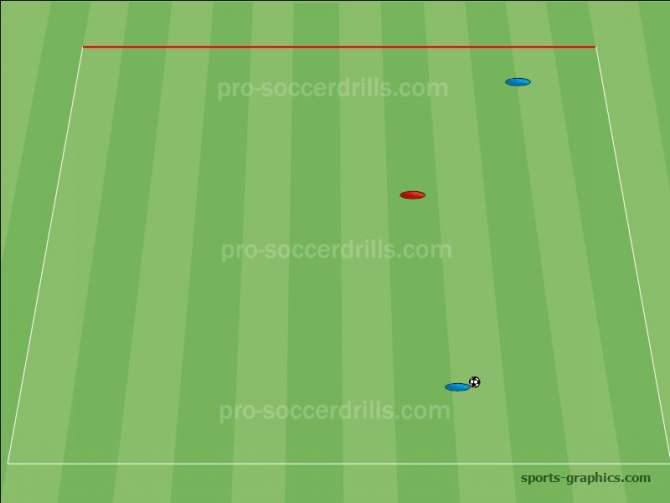
This can be called a vertical 2v1 because with the first pass players win depth and break through at least one line. The same principles can be applied here, too, so the attackers have to solve the situation as fast as they can and as effective as they can. The defender’s task is the same: slow down the attackers and get the ball if possible. According to this the man on the ball should make the defender make a decision otherwise the solution will be too slow. The free man should find a passing lane behind the defender and pick up an open body position to receive the ball and be able to turn towards the end line in order to win the ‘battle’.
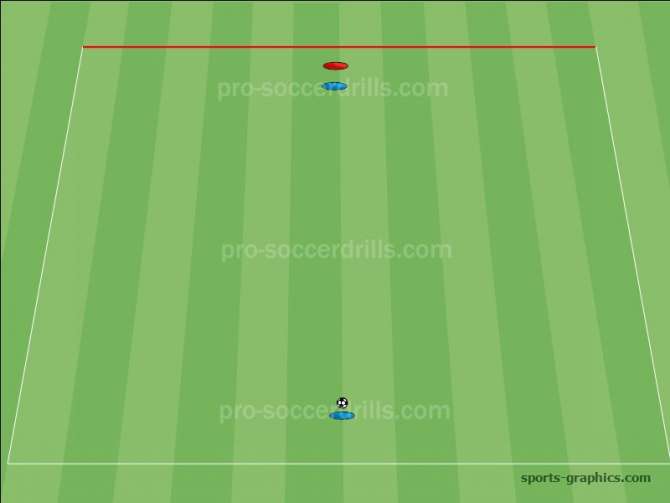
In-game there can happen a situation like this, too. The defender is positioned behind the man without the ball, so the man on the ball is unmarked. There’s a common mistake that coaches start this exercise by making the player on the ball pass to his teammate. If the coach applies the principle that the player on the ball only pass when his teammate in a better position, then this is a controversy because the marked man is in a worse position than the man on the ball. So simply start the situation by dribbling and opening space.
The marked man should decide which way to move. He should move diagonally (not vertically or horizontally) to open up space.
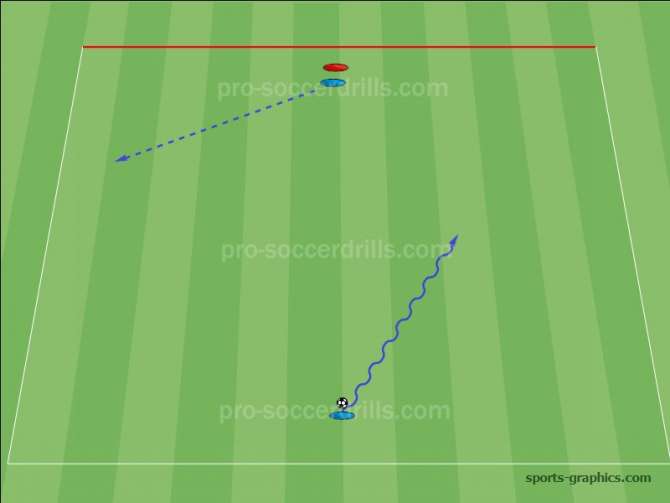
By this movement the attackers win depth and width, all at once. The defender won’t be able to react well and will be forced to make a decision (of reading the pass or the dribbling) instantly. Then there will be a basic 2v1 situation as it was mentioned firstly. Keeping an open body position and body orientation is also important here. Diagonal run helps to pick up this position more than any other angled run.
The solution of these situations are up to the players.
Instructions for the players
It’s the coaches’ interest to make the players think. Players have to recognize these basic situations (although this is quite hard task to do especially with younger kids) and solve them the right and most effective way. Coaches also should motivate and help the players by making them think and act faster.
Firstly, in a 2v1 situation the coach should make the defender put instant pressure on the man on the ball. This will help the ball carrier’s decision making as well as the free man’s. But we mentioned that the defender shouldn’t be forced into a decision-making so later on we can ask the defender to stay and slow the attacker down by stepping back and letting the player on the ball make many touches.
The last step can be the introduction of the 2nd defender who is running back to help his teammate. This will be more of a game-specific exercise that happens many time. The time limit now isn’t given by the coach but the 2nd defender. If the solution takes too much time to the attackers then it will be a 2v2 situation that is so much harder to solve then the 2v1 overloaded situation.
The attackers then always should be encouraged to attack directly and be initiative. Especially the man on the ball who should force the opponent to make a decision. After the defender’s movement and reaction, the attacker should make the right decision: passing or dribbling. Anyway, the most important is to execute this overload as fast and effective as they can.
Summary
In general 2v1 situations are great opportunities to break through the opposition’s lines and get closer to scoring a goal that is the essence of the game of soccer. 2v1 situations of course happen in possession exercises where there is no direction to attack and no direction to defend either. But the principles are the same: be initiative when in possession and make decisions according to the defender’s movement.
There can be many more approaches to 2v1s but the main point is to make the players think and act faster and faster. Players want to learn and develop themselves. By applying a systematic coaching structure, players will be able to become better because they will understand the coaches’ thoughts and ideas.
Here you can read more about creating 2v1 situations in a system of play (4-3-3 now). This may give the coach some thoughts on choosing the right system.
Creating 2v1 Situations in 4:3:3 Formation to Break Through the Defending Line on the Wings
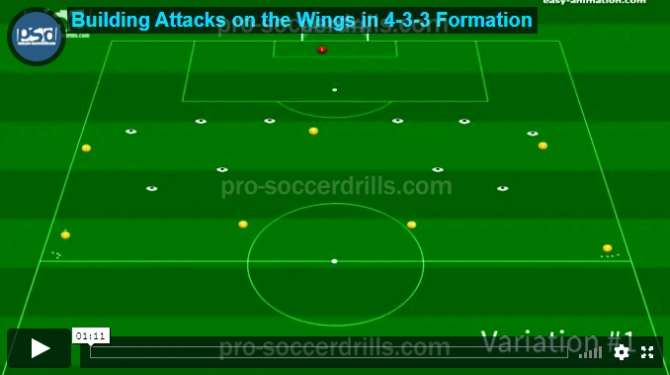
Free Trial
GET YOUR FREE 14 - DAYS TRIAL NOW! INCLUDING:




